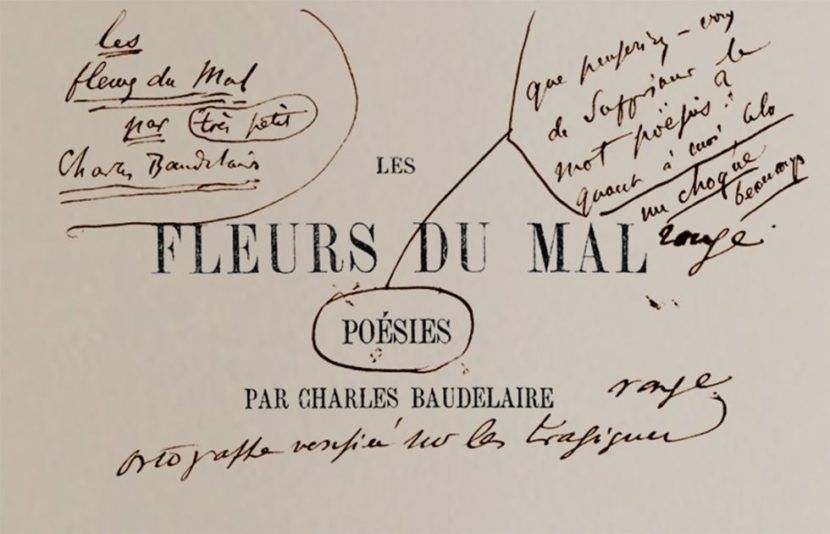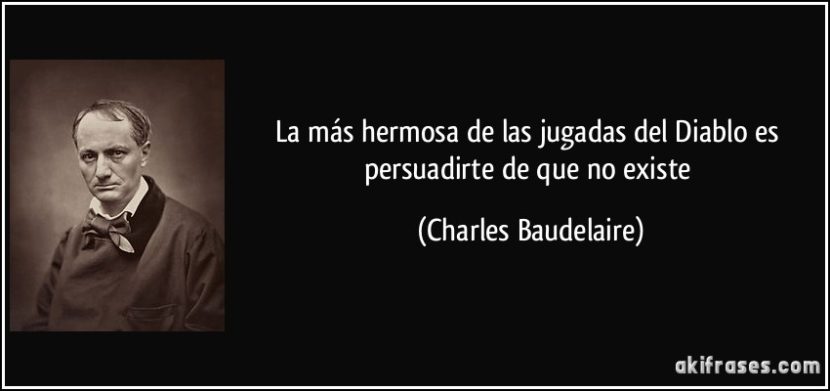
The flowers of Evil.
The flowers of Evil (The evil flowers, in French) is an anthology of cursed poems written by Charles Baudelaire and published in 1857. This is considered one of the most magnificent works of the author, being an example of French symbolism and decadence. The text is a reflection of a time when it was imperative for the author to scandalize the bourgeoisie of the second empire.
Through a masterful use of words, the work served Baudelaire as an escape from the so-called “spleen” (a feeling of anguished boredom that the poet feels when he is rejected by a hypocritical and decadent society). According to the writer, the best way to avoid this regret is through art, poetry, excesses and love, which is not far from suffering. For this and many other of his works Baudelaire is considered one of the great poets of the world.
About the context
To write this work, Charles Baudelaire was inspired by the dirty and dark neighborhoods of the XNUMXth century Paris art scene., where he alternated between prostitutes and hashish, opium and laudanum ... all this to escape a reality that seemed agonizing. In addition to this, modern humanity itself and its frivolity led him to seek the essence of evil, disease, death, and the grotesque.
As a counterpart, Baudelaire He tried to find the light within the darkness that consumed him in those days. However, the author ultimately fell prey to this consistent boredom, which, in turn, led him back on the path of a messy and scandalous life that did not go unnoticed in the city's upper-class atmosphere.
The flowers of Evil
Immersed in his constant state of obsession and his unique vision of evil, Baudelaire wrote what is today considered the best of his works. The flowers of Evil seeks to emphasize the sins of man, emphasizing his ignorance. The work itself is a sample of the illumination of the arts as a reflection of the deepest feelings of the human being.
It was precisely due to its character, grotesque and sublime, that this anthology caused great controversy, causing the poet many legal problems. The author was prosecuted for the content of this volume, and forced to exclude six of his poems as being considered too immoral for the time. On top of that, Baudelaire had to pay a fine of three hundred francs. This, of course, did not prevent a reissue from being made to it in 1861, including some unpublished texts.
The work is considered to have a classical style, and its content is considered romantic. This anthology was designed as a chain of poems that intertwine and are related to each other, as a story in which the protagonist - the poet - gradually falls away from a miserable reality and immerses himself in the excesses of life. drug and erotic pleasure. Being in this state, the poet describes the woman as a malevolent being who avoids her ascent towards enlightenment.

Charles Baudelaire quote.
Modular
This work has undergone several changes in its structure over time. This was due, as mentioned, to the fact that after the conception of the text it was considered an immoral monstrosity that disturbed the order, peace and good customs of the time.
The original book consists of seven parts:
Home
In the first part of the play Baudelaire introduces the public to his vision through his memorable poem "To the reader." Here the writer reveals (in part) what will come later; it is an approach that makes reading more intimate.
Away
After that, he goes to "Spleen and Ideal", where the author proposes his preferred forms to evade the reality in which he must live; a reality full of boredom and ignorance (the "Spleen"). These forms are, of course, art and beauty. In "Ideal" he firmly expresses a gradual escape from this reality that he considers dire.
Third and fourth
In the third and fourth part ("The Flowers of Evil" and "Parisian Paintings") the author tries to find beauty in Paris, the one that he made lost. However, this search is not without atrocities, grotesque scenarios and the evil that Baudelaire embodies so much in his poetry.
Fifth and sixth
When not finding his so dreamed elevation nor the vindication of his city, the author falls back into vices. This is where they come in the fifth and sixth part, "Rebellion" and "The wine", and from them there is no return to a purer life, it is no longer possible, not for Baudelaire, not for his poems.
Final part
In these almost final stages you can see a perfect Dantean painting painted by the poet, which gives way to the seventh and last part, which is none other than "Death". It is here, as its name indicates, that all the decays are consummated in the annihilation of existence. It could not be otherwise.
Baudelaire, with his great capacity for genius for letters, masterfully managed to introduce the reader to the Paris descriptor for him. It is important to note, again, that all this content did not come to light at first due to censorship.
1949 edition
In later editions of The flowers of Evil se include some of the most beautiful love poems by Charles Baudelaire, creating a new structure for the work, which can be read as follows:
- "Al Lector" ("Au Lecteur").
- "Esplín e Ideal" ("Spleen et Idéal").
- "Flowers of Evil" ("Fleurs du Mal").
- "Parisian Paintings" ("Tableaux Parisiens").
- "Rebellion" ("Révolte").
- "The wine" ("Le Vín").
- "Death" ("Le Mort").
Because of the moral conflict that this anthology caused, and the fact that he had to exclude six of his poems, It was not until 1949 that the public was able to enjoy the decadence and eroticism implicit in The flowers of Evil as designed by the author. Something interesting is that corrections of this work are still being published today.
About the Author
Charles Baudelaire was born in Paris; biographies about the author do not clarify whether the year of his birth was 1821, or ten years later. Baudelaire was a poet, art critic, essayist, and translator. In this last job he worked translating the poems and stories of what he considered to be one of the most avant-garde men of his time: Edgar Allan Poe.

Charles Baudelaire.
He is considered one of the most important poets for French symbolism, and the father of decadence.. Baudelaire was seriously criticized for his work, and was included in the category of the "cursed poet", this for his bohemian lifestyle and his extravagant vision of evil, love and death. He was also nicknamed "The Dante of the modern era", thanks to this same vision.